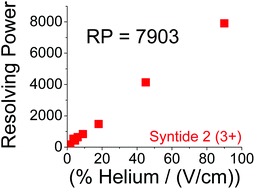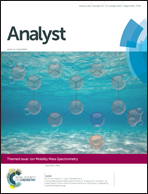Resolving powers of >7900 using linked scans: how well does resolving power describe the separation capability of differential ion mobility spectrometry
Abstract
Differential ion mobility spectrometry (DIMS) separations are described using similar terminology to liquid chromatography, capillary electrophoresis, and drift tube ion mobility spectrometry. The characterization and comparison of all these separations are typically explained in terms of resolving power, resolution, and/or peak capacity. A major difference between these separations is that DIMS separations are in space whereas the others are separations in time. However, whereas separations in time can, in theory, be extended infinitely, separations in space, such as DIMS separations, are constrained by the physical dimensions of the device. One method to increase resolving power of DIMS separations is to use helium in the DIMS carrier gas. However, ions have a greater mobility in helium which causes more ions to be neutralized due to collisions with the DIMS electrodes or electrode housing, i.e. the space constraints. This neutralization of ions can lead to the loss of an entire peak, or peaks, from a DIMS scan. To take advantage of the benefits of helium use while reducing ion losses, linked scans were developed. During a linked scan the amount of helium present in the DIMS carrier gas is decreased as the compensation field is increased. A comparison of linked scans to compensation field scans with constant helium is presented herein. Resolving powers >7900 are obtained with linked scans. However, this result highlights the limitation of using resolving power as a metric to describe DIMS separations.

- This article is part of the themed collection: Ion Mobility Mass Spectrometry

 Please wait while we load your content...
Please wait while we load your content...